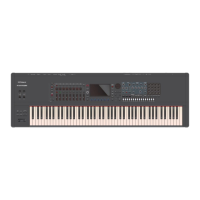88
Recording a Pattern
Step Recording (Step REC)
1.
Press the [7REC] button.
The REC STANDBY screen appears.
2.
Make TRACK/PATTERN settings.
TRACK/PATTERN
Recording
Parameter
Value Explanation
<NEW/MIX>
MIX
Overdub-records into the pattern of the selected
track.
NEW
Newly records into an empty pattern of the selected
track.
<TRACK> 1–16 Selects the track to record.
<PATTERN> A–H Selects the pattern of the track to record.
Using the same operations as in step 3 of “Realtime Recording,”
select the track and pattern that you want to record.
3.
Select [E1] STEP REC.
The STEP RECORDING screen appears.
4.
Make settings for the notes that you want to
enter.
Set the various recording parameters in the screen.
Recording parameter
Input location
Velocity
Note number Duration
Input location
Input location
Note being entered
Information on the last-entered
A previously entered note
Velocity
Recording
Parameter
Value Explanation
Note Type
[E3] knob
1/64 ( )–
2/1 ( )
Specifies the note length (step time) of the notes to
enter. The note length is the length from one note-
on to the next note-on. This step time length is also
used when entering a rest or tie.
Gate Time
[E4] knob
1–100%
Specifies the gate time as a proportion of the note
type. The gate time is the length from note-on to
note-off. Use a low value to produce staccato, or
a high value to produce tenuto or slurs. Normally
you’ll use a setting of approximately “80%.”
Velocity
[E5] knob
REAL,
1–127
Specifies the force with which the key is played. If
you want the velocity of your actual keystroke to be
used, choose “REAL.”
Otherwise specify the desired velocity, using p
(piano) = 60, mf (mezzo forte) = 90, and f (forte) =
120 as approximate guidelines.
5.
Play one note on the keyboard.
The note is recorded at step 1, and the input position in the
screen automatically advances by the length of the step time.
You can record a chord by playing multiple notes simultaneously.
6.
Repeat steps 4–5 to record each step.
You can use the following functions while recording.
Menu Explanation
[E1] REST Enters a rest.
STEP BACK [E2]
Deletes the step data, returning to the input
location one step earlier.
Step [E6] knob Changes the input location.
<TIE> Inputs a tie.
<UNTIE> Deletes the tie that was input immediately before.
If you step-record beyond the specified length of the pattern, the
recording parameter “Length” is automatically adjusted.
7.
Press the [EXIT] button to stop recording.
MEMO
5 By scrolling the keyboard area in the left side of the screen, you can
move the displayed area up or down.
5 By using the piano roll scrollbar in the upper part of the screen, you can
move the displayed area forward or backward through the measures.
Key region of the
display area
Drag left/right
Drag up/down
Display area

